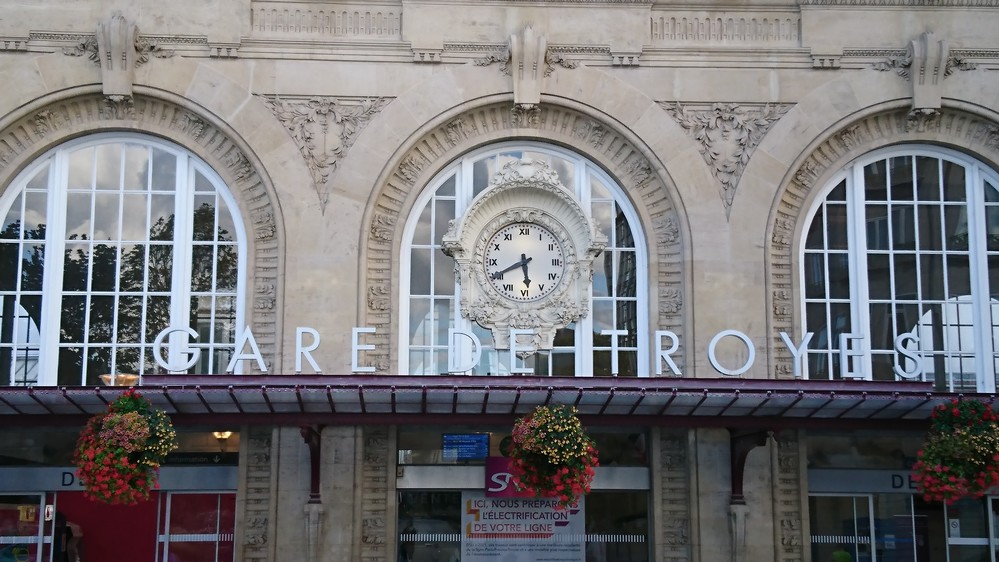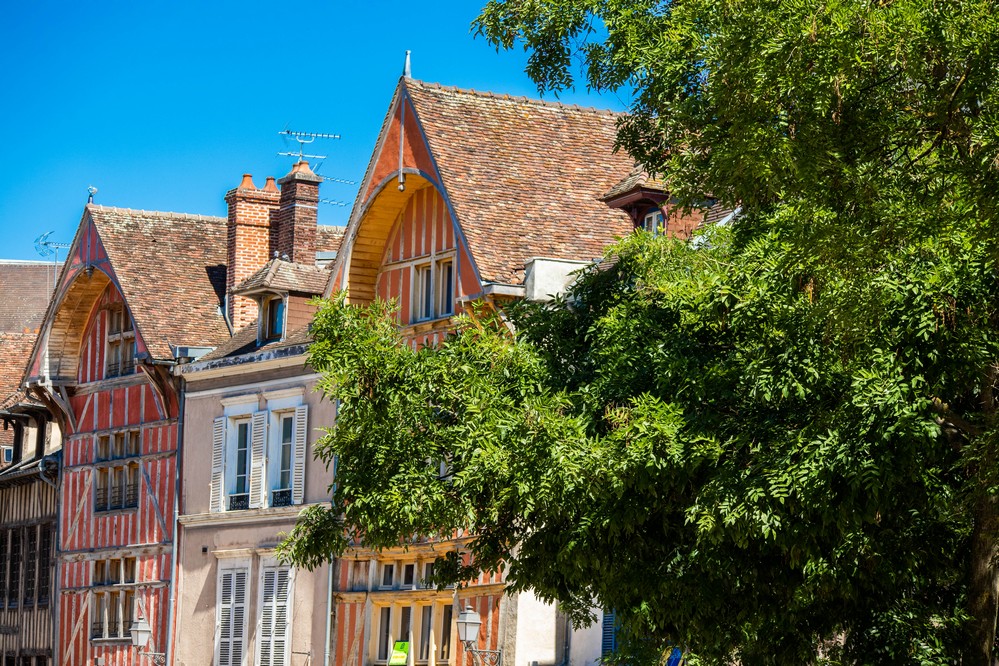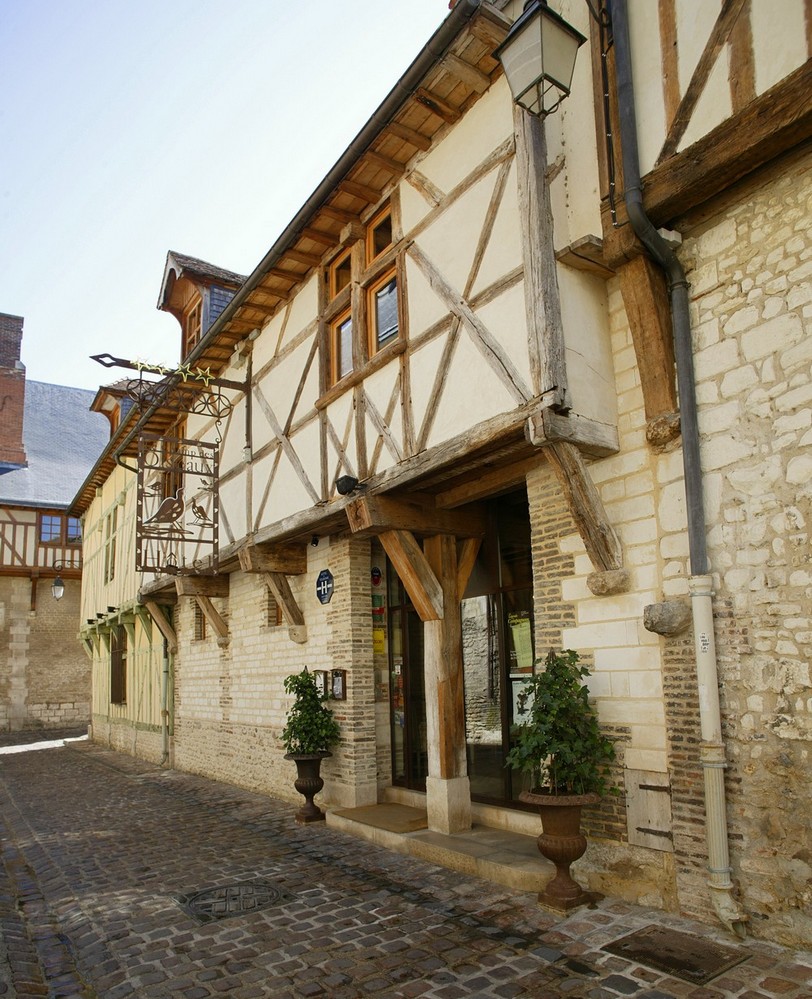Add to bookmark
In 1479, the Council set up in the “cork body” and rented a house near the Saint-Urbain church, then called the Municipal Chamber, with a bell to call meetings. In 1494, the Town Council bought the Mesgrigny hotel, a large 15th century half-timbered building. During the Great Fire of 1524, this building was severely damaged. Therefore, at the beginning of the 17th century, the Town Council decided to build a new Town Hall on its site. For that purpose, Louis XIII authorized the use of a small part of the revenues from the wine and salt taxes. The building was slowly built and completed around 1672. Two wings were added behind the main building in 1933 and 1937 by the architect F. Balley. The central wall has blue marble columns from Tournai and a niche housing a Minerva with a helmet, which replaced a statue of Louis XIV destroyed during the French Revolution. However, there is still a large wooden medallion representing this king, sculpted in 1687 by François Girardon (1628-1715), from Troyes, placed on top of the monumental fireplace of the Town Council Chamber. There is another piece of heritage from the Revolution on the façade, which is the motto that appeared at the time on all the town halls in France: “Unity, Indivisibility of the Republic, Liberty, Equality, Fraternity or Death”.

Completed in 1876, the covered market was created by the municipal architect Emile Bailly. He found inspiration in the covered market recently built in Paris and imagined by Victor Baltard, combining iron, cast iron and glass to make one of the largest covered markets of this type. This construction is typical of the 19th century in its materials and its thin and elegant design: 18 cast iron posts support the huge moulded vault, formed by a roof made of three parts separated by bay windows. A mezzanine was added in 1987. Nowadays, the covered market is one of the favourite daily meeting spots of the citizens of Troyes. There, you can find delicacies and local products from the Aube department (fruits, vegetables, “andouillette”, cheese, champagne…) but also more exotic products, in a friendly atmosphere, particularly lively during weekends.

In 1870, the mayor of the time, Désiré Argence, left a legacy to the city of Troyes. Part of this money was used to build a fountain that would keep his name: the Argence Fountain.
Désiré Argence, mayor of Troyes from 1859 to 1870, also gave his name to the Argence Building (Espace Argence), a cultural and conference centre with a 3,000-seat auditorium and different meeting rooms. The Argence cultural centre also includes the Troyes Conservatory of Music, Dance and Theatre, dedicated to Marcel Landowski (1915-1999), a famous pianist and composer, who had an important influence in the revival of French music. The very contemporary architecture of this building offers a pleasant contrast with the other buildings (entrance on rue de la Paix). It is also where the Municipal Band can be found.
The Troyes train station is located just outside of the “champagne cork”, the historic centre of Troyes. Around 1850, a railway line was created in the East of France (Paris-Troyes-Mulhouse / Belfort), going around the city centre. The railway line was then built on the outer ditches of the old ramparts, near the Ravelin water reservoir. A new train station was built in 1857-58 to replace the “Embarcadère”, the terminus of the old Troyes-Montereau line (this is now the “Espace Argence, a cultural centre). The façade of the train station, listed as a historic monument, is composed of an alignment of semi-circular bays surmounted by a balustrade, probably in reference to the old fortifications. In the middle, a giant clock was finely sculpted. The entrance is made of a large wrought iron canopy, designed by Gustave Eiffel. In 1912, a new neoclassical passenger hall was built next to the train station. In 1982, the train station was renovated, and a modern wing was added.

The former Notre-Dame street (now Emile Zola street) widens out to the west into a large triangular square, formerly known as “Place du Marché-au-blé” (Square of the wheat market). The trade of cereals, which were the basis of the medieval diet, was active and financially worth it. It explains why so many hotels and taverns could be found all around the square for several centuries, as the hotel “du Mulet” (of the mule) or the hotel “des Trois Rois” (of the three kings). But the square was also the place of capital executions: in the 16th century, there were two pillories where outlaws were exposed to the public, and a gallows where criminals were hanged. During the French Revolution, it was decided that executions would be less cruel using a guillotine, so one was installed on this square. Among the most famous condemned people was Claude Gueux, imprisoned in Clairvaux and guillotined in 1832. His execution outraged Victor Hugo who then published his famous pamphlet against the death penalty. On this square, there is also the old “Halle de la Bonneterie” (covered market for the hosiery industry), built in 1837. Hosiery manufacturers used to sell their products there. In 1905, it was converted into the Labour Exchange. Since 1919, the square has been named after Jean Jaurès, an important French politician, deputy in Carmaux (Tarn), socialist and pacifist, who was assassinated in Paris just before the First World War.

This is a historical suburb where the famous Champagne Fairs took place between the 12th and 13th centuries, mainly around the Saint-Jean-au-Marché church and in the adjacent streets and squares, specialising each in one or more types of trade: second-hand clothes, groceries, poultry, drapery, salt… On this square, the money changers and stockbrokers were installed, they were often Jewish or Lombard (from northern Italy), many of them living in Troyes for generations. Nearby, on the Montée-des-Changes street, the hotel “des Angoiselles” was built for a family of Lombard bankers. With the decline of the fares in the 14th century, this square was occupied by horticulturists and herbalists and was therefore called square of the herbs markets. Then, in the 17th century, the bakers occupied it, and this is how it got its current name.

Since the beginning of the 15th century, this Renaissance-style hotel has belonged to an important family of Troyes composed of drapers and magistrates, the Jouvenels, who were ennobled under the name “Juvénal des Ursins”. Champeaux street was even called « rue de la Draperie » (drapery street) by then. Jean Jouvenel or Juvénal (around 1360-1431), a magistrate in Troyes and then in Paris, was appointed provost of the merchants of Paris in 1388. Among his sixteen children was Jean, Archbishop of Reims, who participated in the review of Joan of Arc’s trial, and Guillaume (1401-1472), who was chancellor to the kings of France Charles VII and Louis XI. After the Great Fire of 1524, the hotel was rebuilt in stones. On the facade with its large moulded mullioned windows is added a beautiful three-sides Renaissance-style oriel, topped by a finely sculpted section (restored in the 17th century). The interior stained-glass windows represent the donors and the Crucifixion. The roof has a large 16th-century flamboyant Gothic dormer window.

Emile Zola street has been the major shopping street of the city for centuries. In the past, it was composed of several successive streets, including “rue de l’Épicerie”. At the time of the Champagne Fairs, it was where the spice market took place. Products like pepper, cinnamon, nutmeg, and cumin were imported and stocked by Italian merchants to be sold to traders in Northern Europe. Another part of the street was then called “rue Notre Dame” after a convent located in its end. It was in this street that the Troyes printing industry started in the 15th century. The urban reorganisation of this street and the beautiful renovations that have been made have converted it into an important tourist spot.

Liberation square is an historical place, surrounded by the Prefecture and the Department Hotel. It is also a pivotal spot of Troyes since it is at the junction of the two parts of the city centre, creating a link between what is commonly called in Troyes “the head and the body of the champagne cork”. This square was built on the site of a former cemetery and the “St Jacques Aux Nonnains” church, which was demolished in 1796 to make way for a temporary grain market. Renamed several times, the square was transformed many times. Indeed, it was built in 1912 and adorned with a white marble sculpture of the local sculptor Auguste Suchetet, representing a triton abducting a naiad. It was a square with a certain provincial style that citizens of Troyes enjoyed throughout the last century. Today, it has become a very modern urban park. The garden covers a helical underground car park with a special feature: its 7 levels are decorated with 150 m2 of contemporary stained glass. It creates a certain harmony with the nearby cathedral.

“Hôtel du Petit Louvre” (16th-19th century): this former canon’s house from the 16th century is leaning against the first rampart of the ancient city, near the southern gate. It was the home of Louis Budé, brother of the humanist Guillaume Budé. The turret was rebuilt in 1989 when the building was renovated and it now rests on the very first rampart of Troyes, the remains of which can be seen to the left of the entrance gate. Next to it is the small “Trois-Pierres” (Three-Stones) house, built in 1753, that served a long time as a cobbler’s shop. Today, the entrance opens with a gate that replaces the old oak doors. In the inner courtyard, on the left, the beautiful 16th century half-timbered house still displays its beams with sculpted ends representing figures and polychrome escutcheons, with the one on the right probably made in the 18th century. In the 18th and 19th century, the Bourliet de la Prairie family set up a large post office there: the stagecoaches that were then passing through the gateway of the Linard-Gonthier street reached Paris in a single and final trip of 24 to 30 hours.

Saint-Pierre Saint-Paul Cathedral: built over more than 400 years, the cathedral illustrates the different stages of the Gothic, classical, radiant and flamboyant architectural styles, but the building is still very homogeneous and beautiful both from the outside and inside. It is 114 m long and 29,50 m high, and one of the most famous cathedrals in France, particularly for its listed stained glass windows on 1 500 m2, its elegant style, its quality sculptures, paintings and tapestries. The Saint-Paul tower was never built because of a crisis of faith and a lack of funding. In the choir, 13th century stained glass windows depict Mary, Saint John and various episodes from the Bible. In the nave, a Tree of Jesse (± 1500) can be admired, and in the north aisle of the nave, the Mystic Press (1625) made by Linard Gonthier, a famous master glass artist from Troyes (1565-1642). The choir stalls, made in sculpted wood in the 18th century, come from the Clairvaux abbey, as well as the famous great organ, also built in the 18th century. The cathedral holds a remarkable treasure, built up from 1204 (during the sacking of Constantinople by the Crusaders), including an exceptional collection of shrines (with the head of Saint Bernard de Clairvaux). In 1420, in this cathedral, the “shameful Treaty of Troyes” was claimed, giving the crown of France to Henri V of England. On the 10th of July, 1429, in this same square, Joan of Arc obtained the allegiance of the city to the young Charles VII to “drive the English out of France”, as it is indicated on a plaque at the bottom of the tower.

The Heart of Troyes (Coeur de Troyes) was designed by the local artists Michèle et Thierry Kayo-Houël. It is the centrepiece of the renovation of the quays of the Haute Seine canal. Made by the Sotralinox workshop, this stainless steel lacework is composed of more than 200 pieces assembled together, weighing one and a half tonnes, 4 m wide, 3.5 m high and 2 m deep. At nightfall, dressed in red lights, the Heart lights up and a camera with a computer program animates the light beats as the spectators more forward: it is a beating heart! Set in the middle of the “cork”, between its body and head, this heart symbolises the romanticism of the historic city.
The renovation of the quays of the Seine has created a real living space, where citizens and visitors can walk around and meet up. It has also given a legitimate historical value to the importance of water in our city, and it has marked the presence of the hyper-centre by reconnecting the head and body of the “champagne cork”.
